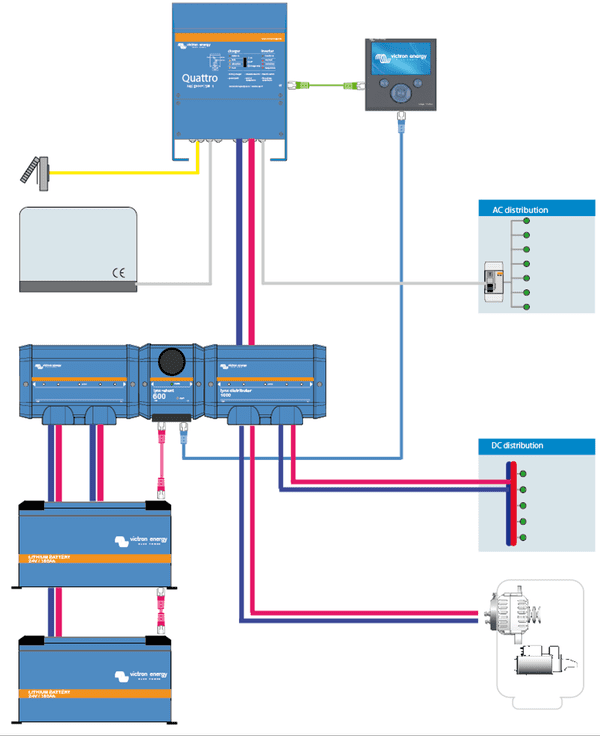Sale of DC Distribution Systems
This page features a catalog with prices for DC Distribution Systems that you can purchase on our marketplace. We offer delivery across Europe and other countries.
If you have any questions or cannot decide which DC Distribution Systems to buy, you can ask our staff through the contact details on the website.
About DC Distribution Systems
Systems with direct current electrical energy distribution have been known for a long time, but previously there was no technical possibility to implement these systems on boats. And yet, with the development of semiconductor technology, such an opportunity has appeared.
The advantage of these systems is that the generating units are capable of operating at variable speed according to the optimal characteristics in terms of fuel consumption. These electrical power systems may use static sources, which typically produce DC power.
When transmitting on alternating current, we are faced with a problem such as reactive power, which constitutes a significant part of the losses in the power line. When distributing direct current electricity along cable routes and busbars, the concept of “reactive power” is absent at all; the conductor is used at 100% of the active power.
Direct current is not subject to skin effect, i.e. the conductor cross-section is fully used. Consequently, with the same conductor cross-section, more power can be transmitted at direct current.
On direct current there are no “evil” harmonics that are present on alternating current. Three-phase alternating current requires four conductors, and direct current requires two. At the same time, at a voltage of 400V, direct current is 2 times safer than alternating current of industrial frequency (50 Hz).
Nevertheless, the mainline transmission of electricity by alternating current still remains the most reliable and efficient method, but local distribution transmission of electricity has become more efficient by constant current. Which, of course, attracted the attention of not only car manufacturers and developers of smart home circuits, but also marine engineers, as well as shipyards producing yachts and boats for mass use.
In addition to efficiency gains of up to 20 percent, other benefits include space and weight savings of up to 30 percent and flexible placement of electrical equipment. This allows for significantly increased cargo space and a more functional vessel layout in which the electrical system is dependent on and designed for the functions of the vessel, rather than the other way around.
Types of DC Distributors
DC distributors are divided depending on their connection to the power source. There are four types of DC distributors with power connection:
- at one end;
- on both ends;
- in the center;
- according to the ring principle.
In a distributor fed from one end, loads are applied at various points along its length. The current in various parts of the distributor, which are remote from the power point, continues to decrease.
The voltage continues to decrease as it moves away from the power point. If a fault is detected in any section of the distributor, the entire distributor must be disconnected from power. For this reason, the continuity of power is interrupted.
In the case where the distributor is connected to the power supply at both ends, the voltage available at the power points may be the same or different. The minimum stress occurs at the load point, which moves due to changes in load on different sections of the distributor.
If a fault is detected at a supply point, continuity of supply from another supply point is ensured. If a fault is observed in the distributor area, it must be ensured that the supply continues on either side of the fault along with the appropriate feed points.
Here the cross-sectional area of the conductor requires a double feed distributor and is less as compared to the requirement for a single feed distributor.
If the distributor is energized at the central point, the voltage drops at the farthest ends. This voltage drop is not as large as in a distributor fed from one end. This is equivalent to two distributors that are fed individually. In this case, each distributor has a common supply point, the length of which is half the total length.
How to Choose DC Distribution System
The surest way to choose the right DC Distribution System is to focus on the characteristics of the buses (panels) that are part of the system.
Here experts distinguish two varieties:
- open bus mode, which is more often used in traditional designs with completely separated power systems;
- closed bus mode, which requires safer assembly, control and use because it is more complex and closely integrated into the overall electrical system of the boat.
Solid-state switching provides smarter safety solutions, which in turn leads to benefits such as savings on fuel and maintenance costs, and reduced environmental impact by significantly reducing operating hours.
When testing a closed bus, its fault tolerance of the connected system is checked, including under conditions of a short circuit under voltage in the most negative failure modes.
Characteristics of Distribution Busbars (Panels)
Distribution busbars allow you to selectively turn on and off those circuits that provide direct current to electrical equipment on board a yacht. They can simultaneously perform electrical system monitoring functions, tracking readings such as current, voltage, or amp-hours.
Boats that are 6-7 meters in length are usually equipped with one or more distribution panels, which provide the ability to switch circuits on and off, provide overload protection, and protect wires from damage.
In simple terms, the circuit will automatically turn off if electricity consumption increases significantly - overcurrent protection will turn on. For this purpose, circuit breakers and fuses are installed in the system.
Different panels can be designed for 4 to 12 circuits, control and protect different “sets” of the ship’s electrical equipment, which may include television and radio receivers, various electronics, lighting, bilge pumps, refrigerators, etc.
What to Look For When Choosing a DC Distribution System
It makes sense to select DC distribution panels based on the number of electrical circuits on the boat. We also advise purchasing DC distribution panels that have special features such as waterproofing, lighting, and built-in meters.
DC panels vary depending on a number of design details. Here are some factors to consider before purchasing them:
- panels must have backlit labels to enable reading at night;
- busbars must be equipped with indicator lamps or LEDs that indicate whether the circuit is switched on;
- since a pair of wires comes from each circuit, a positive and negative bus must be provided.
An Example - Lynx DC Distribution System
Let's look at the options using the example of DC Distribution System from one of the world's best manufacturers of marine equipment - Victron Energy.
Lynx system is a modular DC bus system used for connecting batteries, DC equipment and monitoring battery health. It consists of the following modules:
- Lynx Power In;
- Lynx Shunt;
- Lynx Distributor.
You can use Lynx Distributor or Lynx Power In with or without Lynx shunt.

Lynx Power In
Lynx module Power In is used to connect batteries via external fuses. This is useful if you have multiple parallel devices. Contains negative and positive DC bus with M8 bolts for connecting battery cables. It can pass cables up to 22mm in diameter through the bottom entry guides and without restriction through the two side connections.
Lynx Shunt
Lynx shunt contains a positive bus with space for a fuse and a negative bus with a shunt. Contains battery charge monitoring electronics. The Lynx shunt can send battery monitoring information via the VE.CAN bus to a GX or VGX device or to a third party CANbus monitoring system such as NMEA2000. The Lynx shunt is available with a VE.Can connection.
Fuse
CIP140325000 - CNN 325A/80V Fuse for Lynx Shunt
The fuse is a fast-acting 48 VDC fuse and is rated up to 800 A.
Shunt
Rated current 1000 A
Settings
The setup is similar to the BMV setup and is done through the GX or VGX device.
Lynx Distributor
Contains a positive and negative bus and provides the connection of 4 separate DC circuits, loads or DC groups. It has space for separate DC fuses for each circuit.
Each fuse has an additional LED function to indicate whether the fuse has blown.
If you want to use fuse LEDs on a Lynx distributor, you must also be connected to Lynx Shunt.
The Lynx Shunt contains the necessary wide input power supply (8 to 70 V DC) to output the required 5 V (4.5 to 5.5 V) power to the Lynx distributor circuit board.
RJ11 pins are used to connect Lynx Shunt to the distributor. This RJ11 cable is included with the distributor. The Lynx Shunt has two ports and they can be used.
When everything is OK, only the center LED lights up green; when a fuse is blown (or missing), the center circuit and fuse circuit LEDs turn red. If you are not using all connection points in the DC distributor, you may need to install dummy fuses to turn off the red LEDs.
Circuit Breakers
Uses MEGA fuses. Please note that some MEGA fuses are rated at 36 V only (suitable for 24 V systems). You must use 58/64 V fuses for 48 V systems.
System advantages:
- Increased efficiency due to no longer blocking the system at a certain frequency and independently controlling each energy source to optimize fuel consumption.
- Fuel savings, including by simplifying the installation of energy storage devices such as batteries or supercapacitors into the system. Energy storage will help the engines even out load fluctuations from thrusters and other heavy loads.
- Operational optimization through system flexibility that allows the combination of different energy sources such as engines and turbines.
- Security and selectivity.
Once again, please note that DC links cannot be safely deployed without the necessary protection. If you find it difficult to choose, contact the experts of the topRik marketplace - you will receive a free consultation on all issues related to DC distribution systems.
They will also help you choose the right protective devices for your specific system: DC breaker, fast-blow fuse or circuit breaker, and tell you how to distribute them to ensure reliable protection for the selected DC distribution system for your yacht.
topRik marketplace provides a large selection of protective devices for DC distribution systems, including a solid-state DC switch that can interrupt full fault current in microseconds.


